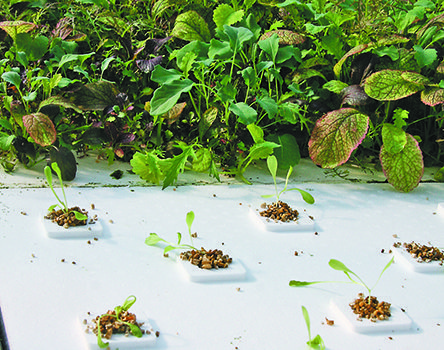Research from a working symbiotic system between fish and plants at Lethbridge College is rippling outward in southern Alberta’s greenhouse industry.
Aquaponics, the practice of raising fish and using their wastewater as plant fertilizer, is used in at least one commercial greenhouse operation in the Medicine Hat region and another may soon be established.
Aquaponics researcher Charlie Shultz of Lethbridge College said Oct. 3 that he is working with AFS Group Ltd., a company that plans a large-scale aquaponic operation that will grow produce for distribution through Red Hat Co-op, the major distributor and marketer of greenhouse produce in the province.
Read Also

Farming Smarter receives financial boost from Alberta government for potato research
Farming Smarter near Lethbridge got a boost to its research equipment, thanks to the Alberta government’s increase in funding for research associations.
Shultz has more than 15 years experience with aquaponics and is working at the college’s facility to enhance knowledge for the greenhouse sector.
He provided an overview last week to a tour group organized by the Oldman Watershed Council.
The aquaponics greenhouse uses water from the adjacent grass carp aquaculture facility. The nutrient-laden water from the fish operation is circulated among plants in the greenhouse.
“These roots, as the water passes through, are cleaning up any of the ammonia, the nitrite, the nitrates that are in the water, as well as all the other plant elements that came from the fish feed.
“They’re pulling it up and by the time it leaves these troughs, it’s pretty clean, almost zero in most nutrients.”
The system allows the fish and greenhouse operations to recycle approximately 98 percent of their needed water, said Shultz.
Solid waste from the aquaculture operation is removed and either used as fertilizer or disposed through the septic system.
Put to use in a commercial operation, a grower can produce two different crops: fish and the greenhouse product of his choice, be it vegetables, herbs or some other crop.
The Lethbridge facility grows grass carp but Shultz said there are fish species that are more commercially viable, such as Asian sea bass and tilapia.
Most plants can thrive in an aquaponics operation, he added, but viable markets will determine the choice.
“Just about every plant I’ve ever tried loves the fish water,” Shultz said.
Tomatoes, cucumbers, mixed greens, cilantro, basil and okra were in evidence during last week’s tour.
He terms the system as “natural” as opposed to organic, due to consumer confusion over the true meaning of organic. Natural pesticides including soap, bacteria and potassium bicarbonate are used when necessary.
However, the idea of vegetables fertilized by fish excrement has proven a hurdle; one Shultz is working to surmount by preparing guidelines and documentation that will satisfy food inspection and food safety agencies.
“A lot of distributors and food chains are happy to take food produced with synthetic chemicals that have been sterilized. It’s a safe food.
But now we’re talking about using effluent from fish. They’re concerned about food safety, E. coli and this kind of stuff,” he said.
As a cold-blooded species, fish do not harbour E. coli, and that’s part of the education process involved in getting wider aquaponics acceptance.
As well, the expense of year-round heating and lighting for aquaponics has to be carefully analyzed.
“It all comes down to the economics again. So is it better just to shut down and not fight the winters? But if you can produce in the winter, you can get a niche price, so it’s a lot of trade offs.”
Shultz said aquaponics appear to be getting more attention from larger companies because of environmental sustainability goals.
“Aquaponics they say is the most productive food production system when it comes to water use, and we’re doing it right here in Lethbridge.”


















